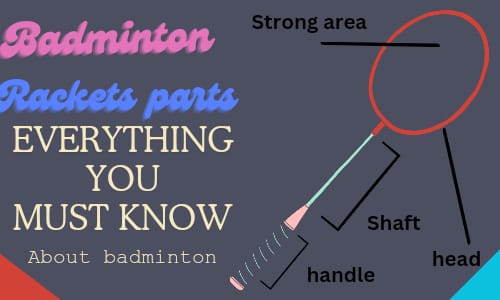Introduction
Badminton, A widely enjoyed sport that is known for its flexibility, speed, and grace. The two main requirements of badminton are shuttlecock and rackets. We already have discussed shuttlecocks, so today we will discuss parts of badminton rackets.
It is essential for both a newbie and experienced players to understand the structure of this vital equipment. The racket is designed to be lightweight yet powerful, which makes it a game-changer in the sport.
By understanding its usage, you can enhance your skills and outperform your opponents on the court. This article is written by an experienced writer so make sure to read it till the end.
Head
The main point of a badminton racket is its head. Strings that control the speed, power, and accuracy of an athlete are located in the head. Because heads come in a variety of sizes and shapes, players may modify their rackets to fit their tastes and playing styles. The badminton rackets come in many varieties. So whether you prefer a smaller head for more control or a larger head for more power you can find rackets of your taste.
Throat
The next section that connects the head to the shaft is the throat which is narrow and small. This essential element gives the rackets stability and balance which helps the player to control their shots. Certain rackets include a grommet strip in the throat that improves the resistance of the string against abrasion.
Shaft
One of the most important parts of a racket’s operation is the long, thin shaft that joins the head and handle. The shaft is constructed of materials like graphite or titanium. The shaft is flexible which directly affects the power and control. Athletes can select a racket with a shaft that suits their style of play. So, the shaft is the backbone of performance.
Handle
The point of contact between the player and the racket is its handle. Synthetic materials such as polyurethane or synthetic leather are typically used to make handles, which are available in a range of sizes and styles. A comfortable grip that takes into account the player’s hand size and preferred grip is ensured by selecting the appropriate handle. If you don’t know how to choose a grip then click the link.
Strings
The point where the shuttlecock meets the racket is the string. It is a cluster of wires that are fixed in the head. When we discuss the strings of a badminton racket, we are getting to the heart of its performance. These tightly stretched ropes form the surface that makes touch with the shuttlecock, and they are more significant than you may imagine. Made from synthetic materials like nylon or polyester, the tension of these strings directly affects how well you’re able to control your shots and release maximum force. Selecting the appropriate strings for your racket is similar to customizing it to fit your playing style. It’s a personal touch that may make all the difference on the court.
Conclusion
When it comes to determining the player’s experience on the court, every component of the badminton racket, as we have explored, is crucial. From the dominant head to the customizable handle grip, knowing these parts allows players to choose their equipment wisely and improves their performance as a whole. So hopefully this will help you a lot. If any doubt let me know in the comments.
FAQs
How often should I replace the strings on my badminton racket? Every 20 to 30 hours of play, regular players should change their strings. But, it’s wise to look for wear indicators like fraying or loss of tension and replace them as necessary.
What is the ideal grip size for a badminton racket? Your hand size determines the appropriate grip size. Measure the distance between the tip of your ring finger and the second lifeline. A grip size between G4 and G5 is comfortable for most adults.
Can I customize the color and design of my badminton racket? Yes, a lot of manufacturers provide choices for customization. But, as they can have limitations on the racket, it’s crucial to review the rules of each organized competition you take part in.


2 thoughts on “A Complete Guide to the Parts of Badminton Rackets””